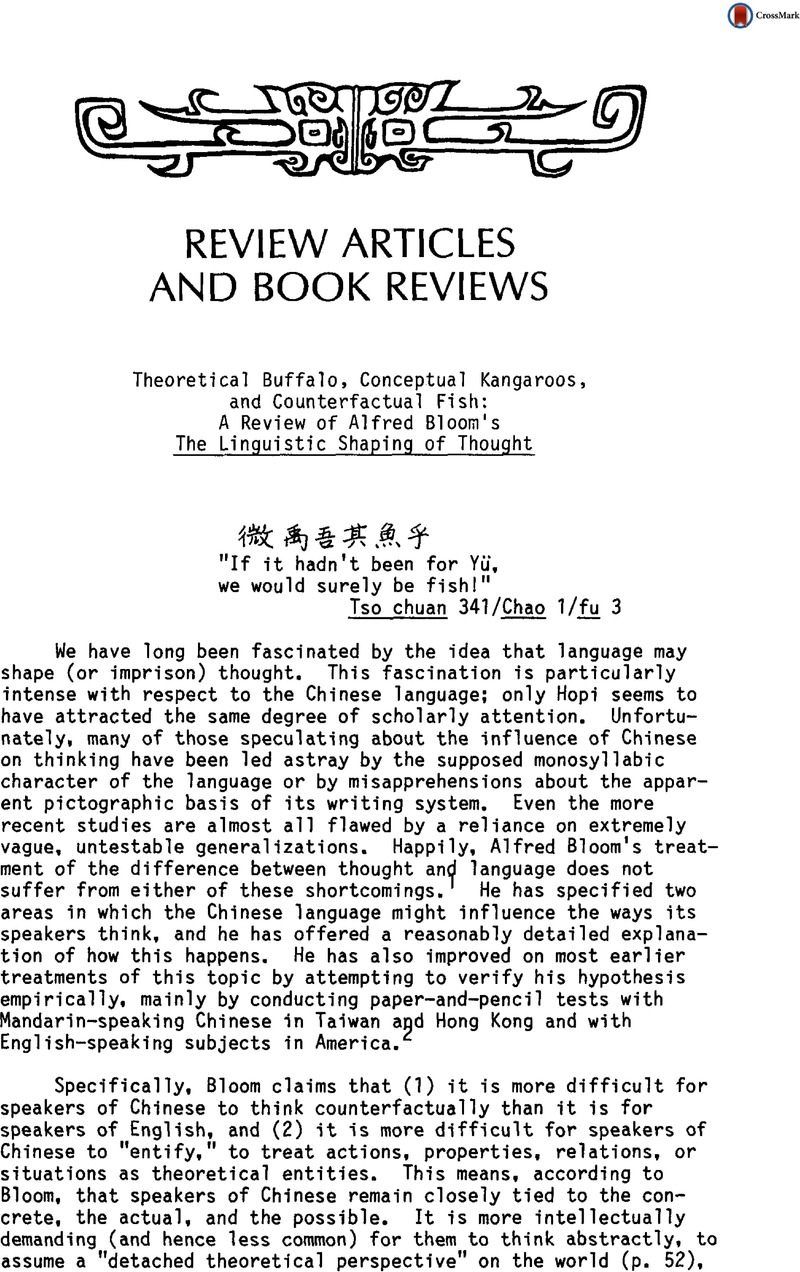Article contents
Theoretical Buffalo, Conceptual Kangaroos, and Counterfactual Fish: A Review of Alfred Bloom's The Linguistic Shaping of Thought
Published online by Cambridge University Press: 26 March 2015
Abstract

- Type
- REVIEW ARTICLES AND BOOK REVIEWS
- Information
- Copyright
- Copyright © Society for the Study of Early China 1983
References
NOTES
1. Bloonu, Alfred. The Linguistic Shaping of Thought: A Study in the Impact of Language on Thinking in China and the West. ix, 101 pp. Hillsdale, N.J.: Lawrence Erlbaum Associates, 1981. $19.95Google Scholar.
2. I am indebted to Sue Glover for her perceptive criticisms of earlier versions of this review.
3. This is attested to by no less an authority than Y, R, Chao, who states flatly that “there is no special way of expressing counterfactuals in Chinese, In practice, unlikely or impossible suppositions more often, though not necessarily, go with the less frequently used of the ‘if’ words….” ( Aspects of Chinese Sociolinquistics [Stanford: Stanford University Press, 1976], p. 257 Google Scholar).
4. Compare to the use of fei as preposed particle, where the counterfactual implication is 1acking:
Who other than Yu would be able to accomplish it? Tso chuan 327/Hsianq 29/tso 8
If it were anyone but his ruler, Po Yi would not serve him; if it were any one but his friend, he would not treat him as a friend. Meng-tzu 13/2A/9
Only if he has gotten where he is by proceeding from the way should you have contact with him; if from something other than the way, avoid him. Hsün-tzu 3/1/40-41
5. Wei appears once in the Lun-yü, the Han fei-tzu, and the Kuan-tzu, twice in the Shih-ching, six times in the Lü-shih ch'un-ch'iu. eight times in the Kuo-yü, and fourteen times in the Tso–chüan. Whenever possible, citations are to the Harvard-Yenching concordances.
6. Kuo-yü Wei-shih chieh (Taipei: Shih-chieh shu-chü, 1975), p. 61 Google Scholar.
7. There may be one other Warring States appearance of this counterfactual particle, in the Shih-ching. Written as ![]() it occurs twice in the poem “yi”
it occurs twice in the poem “yi” ![]() . Unfortunately, it is not clear from the context if a counterfactual meaning was intended.
. Unfortunately, it is not clear from the context if a counterfactual meaning was intended.
If you were to say (?), “You do not know,” still, I have cradled you in my arms.
If you were to say(?), “You do not know,” still, I am well advanced In years. Shih-ching 68/256/10, 11.
Written again as ![]() , this particle was also used in the Shih-chi, and here it did indicate counterfactuality; for examples, see the
Tz'u ch'üan
, this particle was also used in the Shih-chi, and here it did indicate counterfactuality; for examples, see the
Tz'u ch'üan
![]() (Taipei: Tai-wan shang-wu yin-shu kuan, 1929), 6.37-38Google Scholar. This suggests that it may have been used in other Warring States texts now lost to us.
(Taipei: Tai-wan shang-wu yin-shu kuan, 1929), 6.37-38Google Scholar. This suggests that it may have been used in other Warring States texts now lost to us.
8. Chan-kuo ts'e. (1800; reprint ed., Ssu-pu ts'ung k'an. Shanghai: Shang-wu yin-shu kuan, 1922)Google Scholar, 3.68a-b. Translated by Crump, James I., Chan-kuo ts'e. 2nd ed. rev. (San Francisco: Chinese Materials Center, Inc., 1979), pp. 128–129 Google Scholar.
9. Cikoski, John S., “An Outline Sketch of Sentence Structures and Word Classes in Classical Chinese-Three Essays on Classical Chinese Grammar I” Computational Analyses of Asian and African Languages, no, 8 (01 1978), pp. 99–105 Google Scholar.
10. See Graham, A. C., Later Mohist Logic. Ethics and Science (Hong Kong: Chinese University Press, 1978)Google Scholar.
11. Ibid,, pp. 111-165, passim.
12. Ibid., p. 249. He translates the line there as follows.

Supposing that the whole world would be harmed if of all men Jack were to die, I would make a point of caring for Jack 10, 000 times more, but not love Jack more.
13. Piaget was thinking of other cultures when he stated this view; see his “Need and Significance of Cross-cultural Studies in Genetic Psychology” (in Culture and Cognition, ed. Berry, J. W. and Dasen, P. R. [London: Mathuen and Co., 1976], p. 309 Google Scholar). Hallpike, C. R. builds on Piaget's work to explain why other (non-Western) cultures may fail to reach the higher stages in Piaget's model, in The Foundations of Primitive Thought (Oxford: Clarendon Press, 1979 Google Scholar). However, those researchers who ask whether all Westerners reach the formal operational stage are generally answering no. For example, Patricia Teague Ashton notes that “Piaget considers that a 75-percent success rate indicates the general presence of a particular thought process. But in studies of late adolescents in Western cultures, the percentage of subjects succeeding at formal operational tasks is typical ly between 30 and 50 percent” (“Cross-cultural Piagetian Research: An Experimental Perspective,” in Stage Theories of Cognitive and Moral Development: Criticisms and Applications. Harvard Educational Review reprint 13 [1978], p. 11 Google Scholar).
14. For a more extended development of the argument presented in this article, as well as full citations, see Garrett, M., “The Mo-tzu and the Lü-shih ch'un-ch'iu: A Case Study of Classical Chinese Theory and Practice of Argument” (Ph. D. diss., University of California, Berkeley, 1983), ch. 3Google Scholar.
- 1
- Cited by


